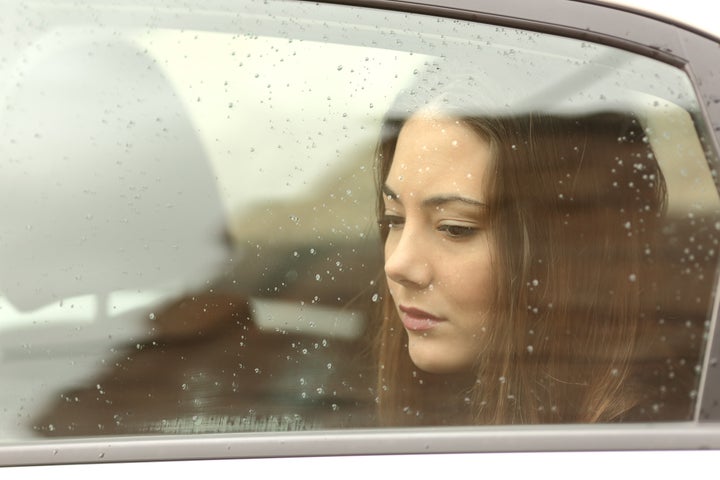Katie* had her first panic attack when she was 12 years old. She was frightened and had no idea what was happening to her.
“She felt as though she may die,” explained her dad, Tom Grinsted, from Suffolk. “She could not understand what was happening.
“As a parent it is frightening to see your child so highly stressed. You don’t have a handbook. You can only go by your own gut feeling.”
Over the last four years Katie has suffered panic attacks sporadically. She is never sure when one will be triggered and they can catch her off guard when she is in school or out with friends.
Katie’s experience is far from unique - around one in 50 teenagers experience panic attacks, according to Anxiety UK. So what can parents do to help?

Panic attacks are caused by underlying anxiety, Emma Saddleton, parents’ helpline operations manager at Young Minds told HuffPost UK - and anxiety is the single most common problem the charity hears about in their 14,000 calls to their helpline every year.
“Anxiety is massive,” said Saddleton. “In teenagers, this feeling can often present itself in panic attacks.”
Why might your child be having a panic attack?
When your child is in a state of distress it is only natural for parents to want to get to the root of the problem, but with panic attacks it may not always be possible to identify a set list of triggers.
This is the case for Katie.
“They range from her feeling crushed at a music concert or having an attack over getting the school bus in the morning,” her father explained.
“The hardest thing is that she can never tell you what it is that has triggered the attack. At the time she gets very distressed.”
Polly Waite, associate professor of clinical psychology at Reading University and Anxiety UK supporter, explained every person who suffers panic attacks must be treated as an individual.
“Panic attacks can often be in response to a situation or trigger that the person is afraid of, such as having to perform in front of others, being away from home or doing an exam,” she said.
“However, sometimes panic attacks can occur out of the blue with no identifiable trigger, perhaps related to having a bodily sensation (e.g. a pain in the chest, feeling lightheaded after doing exercise) or having a particular thought.”
What are the symptoms of a panic attack?
Grinsted said his daughter’s panic attacks begin with her struggling to breathe and starting to hyperventilate - symptoms which increase her distress.
Panic attacks in children and young people involve an abrupt onset of intense fear or discomfort that reaches a peak within minutes, said Waite.
A young person will experience physical signs of a panic attack: They are likely to hyperventilate, experience breathlessness, chest pains, and have pins and needles.
Dr Camilla Rosan, programme lead for families, children and young people at the Mental Health Foundation said some other physical symptoms to look out for include feeling sick, sweating, shaking and a racing and pounding heart.
Mentally, children are likely to feel out of control and panicky, and will find it hard to string a sentence together or articulate how they feel.
“Your child will have that overall sense of ‘I don’t know what is happening’,” Saddleton explained.
“Young people will be scared as they are out of control of the situation and feel as if it won’t get better.
“It will often feel, for the child, as if it is coming out of nowhere, because it can happen at any time.”
What should parents do if their child is having a panic attack?
Do not dismiss their feelings.
Rosan said parents should remember the young person is feeling a sense of uncontrollable fear that they may not understand the reasons for, adding: “Try not to dismiss it even if it feels irrational to you.
“Acknowledge how scary things feel for them and remind them this will pass, remind them that though scary, it is the body’s normal and natural response. This can help them to know they’re safe and what they’re experiencing is understood.”
Stay calm.
Saddleton said seeing a child having an attack will be frightening for parents, but it’s important to try and mask your worries, as kids of all ages will soak up the anxiety of adults around them.
“Talk in a soothing manner,” she said. “Say: ‘Darling, everything is going to be okay’.
“Talk to them, but don’t expect them to talk back. Tell them to listen to your voice, hold their hand, and keep explaining that it will pass.”
After four years of helping his daughter weather panic attacks, Grinsted said he is now able to remain calm when one occurs.
“I talk in a a calm, soothing manner but forcefully to try and get the message of safety across to her,” he said.
Practise breathing exercises.
“Do some breathing exercises with your child,” Saddleton advised. “Say to them: ‘Just breathe in and out with me’, then breathe in for five, and out for five. Do this for several minutes while you sit with them.”
This is something Grinsted does with Katie.
“I have always hugged my daughter, accentuated my breathing and got her to mirror my breathing,” he explained. “Sometimes breathing at her pace to begin with and then slowing down.
“My theory is that while you may not be able to convince her brain, her body will feel the calmness in my body and begin to slow down. ”
The ‘Calm’ app can help with this, suggested Dr Rosen. It has a free function that can help you to relax and regulate breathing by following a dot as it passes on the screen.
Consider emergency services.
If it is the first time it has happened and you are unsure whether or not it is a panic attack, Rosan advises that you can call 111 and talk a nurse through the symptoms you are seeing.
Saddleton said for the majority of panic attacks, the emergency services aren’t needed but it’s important to make an assessment as a parent as to whether this is the case.
If the attack is not subsiding after 20-30 minutes, this may be an option.
Always look into aftercare.
“Aftercare is extremely important,” said Saddleton. “Go to the GP later that day or in the week and recognise there may be a larger problem.
“Really, the issue isn’t the panic attack, which is just a momentary manifestation, it’s about the anxiety underlying the panic attack.
“The longer term issues are what need to be looked at and discussed with professionals.”
Initially Katie did not want her father to let anyone else know she was having panic attacks.
“She was worried the teachers would look unfavourably upon her”, Grinstead explained.
But, after some convincing he was able to get her professional help and she tried hypnotherapy.
Speak to your child about how they’re feeling.
After your child has had a panic attack, it’s important to pick a time to talk to them when they are calm, happy and in control about how they’re feeling.
“Make sure you tell them you are not angry or ashamed, let them know you are proud of them for their bravery and resilience at such a tough time and ask them what you can do to support them,” Saddleton said.
“Set the scene so they know their parents are supportive and recognise how difficult it was for them.
“You don’t have to talk directly about the panic attack, ask them generally how they are feeling about school and aspects of their lives to see if anything may have prompted the panic attack.”
Monitor whether the attacks are regular.
Rosan said: “If the panic attacks happen more than once and are causing the young person concern and distress, it may be that they have Panic Disorder.
“Fortunately, persistent panic attacks often respond very well to interventions such as cognitive-behavioural therapy (CBT), which should be available through local child and adolescent mental health services (CAMHS). In the first instance, it is important to take your child to the GP to decide together the best course of action.”
Confide in the school.
Mark Rees, ambassador for No Panic, a charity providing support to those with anxiety disorders, said it is important to speak to the school about your child and their panic attacks.
“A member of staff may need to get more information on how they can help the child and what to do if a panic attacks occurs during school hours,” he said.
“It is important to agree on a strategy to deal with panic attacks within the school system. It is not advantageous to require the parent to come into school for each panic attack as it creates a reliance that could be problematic.
“Teaching the staff around the child, and the child themselves, how to deal with panic attack is the best way to deal with it.
“During the contact with the school, all of this needs to be agreed upon and measurers put in place.”
* Name has been changed.
For more information:
Anxiety UK: The national charity helping people with anxiety has a wealth of information online as well as a helpline: 08444 775 774.
No Panic: A site providing valuable information for sufferers and carers of people with panic, anxiety, phobias and Obsessive Compulsive Disorders (OCD). They have a general helpline (0844 967 4848) and a youth-based helpline (0330 606 1174).
YoungMinds: A national charity focusing on improving child mental health. Their parents helpline number is 08088025544.
Mental Health Foundation: An organisation researching mental health through practical-based studies.
